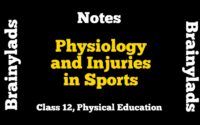Psychology and Sports Class 12 Notes | Questions Answers |
Psychology and Sports Class 12 Notes | Physical Education | Term2 | Questions Answers |
Physical Education : Psychology and Sports Class 12
Psychology and Sports : Sports physiology, sports biomechanics and sports psychology are the factors that highly influence enhancement in performance of an athlete. Though sports physiology and sports biomechanics are helpful in enhancing the performance to a limited extent yet sports psychology has no such limit. Various psychological factors such as motivation, interest, attitude, emotions, stress and anxiety affects the sports performance of an individual. Proper motivation strategies can be highly effective in enhance the level of the sports performance of a sportsperson. Let’s have a look at some important questions of the Chapter Psychology and Sports Class 12.
Questions / Answers of Psychology and Sports
Question 1: What do you mean by the term ‘Personality’?
Answer: The integration of an individual structures, attitudes, mode of interest, capacities, abilities, behaviour and attitudes is generally defined as the personality.
Question 2: What are the four dimensions of personality?
Answer: The four dimensions of personality that together make the personality of an individuals are
- Physical dimension
- Mental dimension
- Social dimension
- Emotional dimension
Question 3: What do you mean by mental dimension of the personality?
Answer: It is that dimension of personality that is related to mental and intellectual strength and abilities. It is a well-known fact that the real personality lies in the mental dimension. An individual cannot contribute to the society until and unless he is mentally sound and has some attained ample knowledge. There are many great personalities of the world who possessed mental in intellectual qualities but are not good looking.
Question 4: State the physical and social dimension of personality?
Answer: Physical Dimension: It is that dimension of personality that is related to good physique, good appearance and good health. An individual who has good height, well proportionate body weight, good posture and bright face are generally impressed by the persons. It is also well known fact that sound mind exists in a sound body. Balanced diet, physical exercises and various other environmental factors improve the appearance poster and glow on the face of an individual.
Social Dimension: It is a significant dimension of personality. We all live in a society where socialization takes place. In a human personality the seeds of sociability we are soon right from the time of an individual’s birth. Morality, manners, work ethics, good attitude, cooperation, sympathy, kindness are the social traits that are required for a good personality.
Question 5: State about emotional dimension of personality in brief.
Answer: It is a significant dimension of personality that is related to emotional stability. To have emotional stability is a necessary aspect of an individual’s personality. An individual should have proper control over variable emotions like fear, anger, disgust, distress and happiness in variable situations. Outburst of various emotions is not a good sign of personality that shows the immaturity of an individual.
Question 6: Briefly discuss about the four types of personality?
Answer: Type A personality- Individuals with this type of personality are characterized by high working involvement and are competitive and self critical. They got easily excited an experience a high sense of urgency that is they always struggle against the clock.
Type B personality- They are easy going, patient and not competitive in nature. They do not get angry easily and are able to express their emotions appropriately. The could be called successful person in life since they are quite satisfied with their lives.
Type C personality- The individuals with this type of personality are able to suppress their emotions effectively and have pleasing and appeasing nature. They start feeling lonely at an early age.
Type D personality – They persistently suppress their feelings and do not share their emotions with other person since they always have a fear of rejection. They have higher risk of premature death.
Question 7: Discuss about Jung’s classification of personality.
Answer: C G Jung classified the personality on the basis of sociability character as discussed below:
- Introverts: Shyness, social withdrawal, Self centred, unable to adjust socially and tendency to talk less are the characteristics shown by such persons. They seem to be sensible and future oriented.
- Extroverts: They are highly friendly, talkative, outgoing, generous, supportive, courageous and social in nature. We can also be called happy-go-lucky persons. They are not easily affected by difficulties and troubles and take decision and act upon it quickly.
- Ambiverts: The individuals who possesses the qualities or traits of both introverts and extroverts are ambiverts.
Question 8: What do you mean by big five personality theory?
Answer: The five factors of personality are considered as the five main the domains that explains the human personality and account for individual differences.
- Openness- Imaginative, Insightful and having the variety of interests are the traits included in openness. The individuals who like to learn new things, new concept and enjoy a new experience usually remain on top in openness.
- Conscientiousness- Such individuals are reliable, prompt and can remain organised, systematic, laborious and complete in all respects.
- Extroversion- They get their energy from interacting with other individuals. Being energetic, talkative and assertive are the traits included in extroversion.
- Agreeableness- Such individuals are compatible, kind, cooperative, friendly, gentle, affectionate and sympathetic.
- Neuroticism- It is also considered as emotional stability. The individuals having high neuroticism usually experience emotional instability and negative emotions.
Question 9: Discuss about William Herbert Sheldon Classification of personality?
Answer: Sheldon classification of personality is as follows:
- Endomorph- These individuals have rounded physique and shorter limbs because of excessive deposition of adipose tissue. The upper part of arms and legs are thicker as compared to the lower part. They found it difficult to lose weight. The fat storage capacity is high in such individuals. They are suitable for sports in game like weightlifting and powerlifting.
- Mesomorph- They have athletic physique and balanced body composition. Deccan easily increase muscle size and have well developed rectangular shaped body. Bones and muscles are thick and chest in shoulder and larger and growth in comparison to its line. They have capacity of doing a lot of activities. The fat distribution is evenly all over their bodies.
- Ectomorph- These individuals are usually referred as slim person since their muscles and limbs are elongated. The weak constitution of body leads to great difficulties in gaining weight. The appear taller than they really are due to the lack of muscle mass. The body structure make them suitable for aerobic activities.
Question 10: Define motivation and elucidate about types of motivation?
Answer: The condition that energize and direct and individuals action is known as motivation. The two type of motivations are as discussed below:
- Intrinsic Motivation – As the word intrinsic suggests internal this type of motivation occur when people are forced to to something out of pleasure and desire. When an individual indulges in any sports activity to gain social approval it is an example of intrinsic motivation.
- Extrinsic Motivation- This type of motivation is external it occurs when external factors such as punishment praise blame reward cash prize compel an individual to do something.
Question 11: Explain various techniques of motivation for higher achievement in sports.
Answer: The techniques of motivation are as discussed below:
Goal Setting – It is one of the most significant technique of motivation. A sports person should be encouraged to set long term achievable goals. The goal should be according to capabilities in capacities of an individual.
- Verbal comments – Beginners are generally easily motivated by verbal comments. They should be applied during the competition and at appropriate time.
- Praises or blame- These factors could work effectively if given at the proper time and in appropriate amount. It could also be dangerous if blame is given at an inappropriate time. Too much Play School also destroy the future of the sportsman.
- Positive attitude- Sportsperson should be encouraged by the coach for positive attitude among themselves. An individual must always have a feel that they can achieve anything.
- Cash prizes, certificates n trophies- These also prove to be a good source of motivation for a sportsman who are not economically sound. Government should offer cash prizes to the sports persons to motivate them.
- Motivational music- It can effectively increase the work output and reduce perceived exertion. During the circuit training fast music is appropriate and slow music during the recovery period is suitable.
Question 12: What do you understand by aggression? What are the three types of aggression?
Answer: The form of behaviour that is directed with the aim of harming or engineering and other living being who is motivated to avoid such treatment is generally defined as aggression. It is an intentional behaviour. Accidental ham is not included in it. It is simply a destructive behaviour that is caused due to frustration. There are three types of aggression as discussed below:
- Hostile aggression
- Instrumental aggression
- Assertive behaviour
Question 13: Discuss about the three types of aggression in detail.
Answer: There are following types of aggression:
- Hostile aggression: It is referred as reactive aggression and the main aim is to cause injury to any sportsperson or any opponent. It is accompanied by anger. Harm could be physical or psychological.
- Instrumental aggression: It is also known as channelled aggression. In this type of aggression, the main aim is to hurt in order to achieve money, praise or victory. The athlete may intend to hurt the opponent but the primary focus is to win the competition.
- Assertive Behaviour: It is a behaviour that involve the use of verbal force in order to achieve one’s purpose. It can be correlated as goal directed with no aim to particular intention to harm with use of legitimate forces with no rules broken. It simply refers as goal oriented, no intention to harm, use of only legitimate force and not breaking of any rule of the game or sport.
Related
|
|
Do share this post if you liked Psychology and Sports Class 12 Notes. For more updates, keep logging on BrainyLads.


